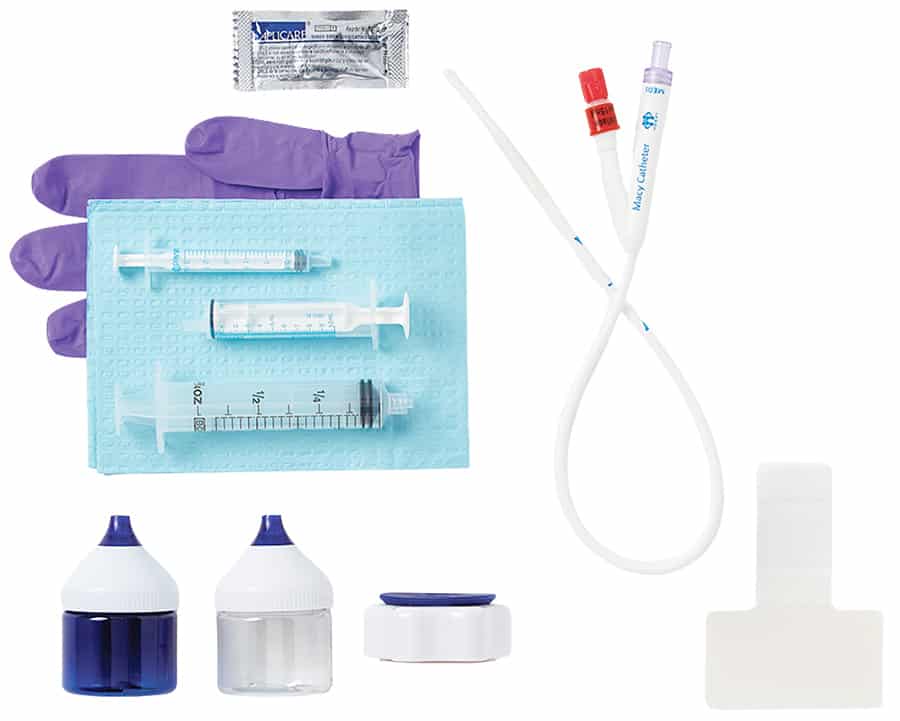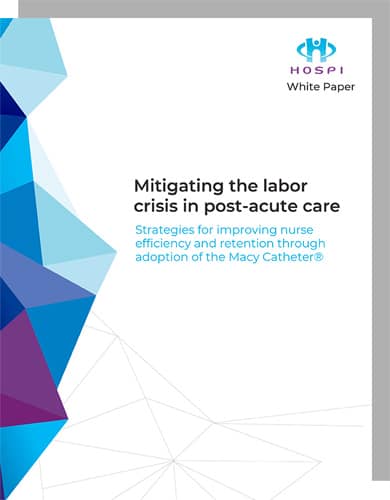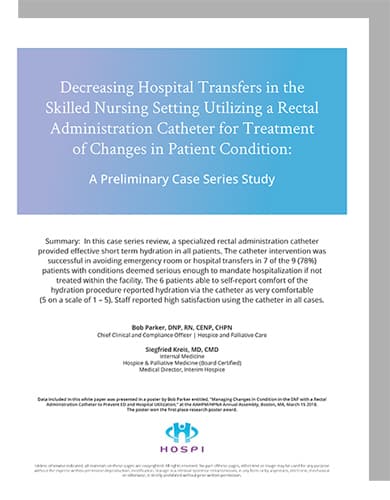Skilled Nursing Facilities
Discover how the Macy Catheter® can improve patient care while reducing triage, costs, and delays.

The impact has been huge.
We were really struggling with the shortage of IV pain medications. With the Macy Catheter, we were able to utilize readily available pill form medications and give them to patients right away. So, we really didn’t see a negative impact during that shortage, which was really great.
Trisha Kendall, RN
Clinical Nurse Specialist – Gilchrist Hospice Care of Maryland

We were really struggling with the shortage of IV pain medications. With the Macy Catheter, we were able to utilize readily available pill form medications and give them to patients right away. So, we really didn’t see a negative impact during that shortage, which was really great.
Clinical Nurse Specialist – Gilchrist Hospice Care of Maryland
Why the Macy Catheter?
No needles. No complex delivery, set-up, or maintenance.
Reduce unnecessary hospital transfers. Palliate severe symptoms quickly.

Patented and FDA-cleared to provide rectal access for administration of medications and fluids

Can be used to rehydrate and calm patients until IV access is easier

Can be used until the oral route is viable

Safer and more comfortable method of medication administration than other options like IV and SubQ

Easy set-up, maintenance, and drug disposal

Non sterile placement; can be placed by any licensed clinician

Why choose the rectal route?
Medications work more quickly and more effectively when administered via the rectal route.
The rectal vault is very vascular, even at the end of life, and it contains a large number of absorptive cells in the lining. At the end of life, patients have less or non-existent intake and are often dehydrated due to the nature of the disease process.

The traditional practice of inserting a tablet or even a suppository directly into the rectum is ineffective because the rectum is too dry at end of life to adequately absorb or dissolve the medication.
However, when medications are crushed and mixed with water to make a suspension and then injected directly into the dry rectal vault, medication absorption is quick and effective.
The Macy Catheter is well-suited for rapid control of severe symptoms. The device is especially relevant when the patient’s oral route is compromised.
Mild or moderate symptoms can sometimes be managed with the sublingual route. However, if the medication volume is too large for effective sublingual absorption or if the patient has heavy secretions, then the Macy Catheter is a logical alternative. The device removes risk of aspiration and the patient will not be subjected to the frequent interruptions and terrible taste associated with sublingual administration.
Symptoms may include:
Pain • Agitation • Shortness of breath • Fever • Seizures • Nausea and vomiting
Why choose the rectal route?
Medications work more quickly and more effectively when administered via the rectal route.
The rectal vault is very vascular, even at the end of life, and it contains a large number of absorptive cells in the lining. At the end of life, patients have less or non-existent intake and are often dehydrated due to the nature of the disease process.

The traditional practice of inserting a tablet or even a suppository directly into the rectum is ineffective because the rectum is too dry at end of life to adequately absorb or dissolve the medication.
However, when medications are crushed and mixed with water to make a suspension and then injected directly into the dry rectal vault, medication absorption is quick and effective.
The Macy Catheter is well-suited for rapid control of severe symptoms. The device is especially relevant when the patient’s oral route is compromised.
Mild or moderate symptoms can sometimes be managed with the sublingual route. However, if the medication volume is too large for effective sublingual absorption or if the patient has heavy secretions, then the Macy Catheter is a logical alternative. The device removes risk of aspiration and the patient will not be subjected to the frequent interruptions and terrible taste associated with sublingual administration.
Symptoms may include:
Pain • Agitation • Shortness of breath • Fever • Seizures • Nausea and vomiting
Resources
Publications and product information can help you learn more about the Macy Catheter.
Resources
Publications and product information can help you learn more about the Macy Catheter.
Featured Webinars
Hospi’s webinars feature thought leaders in post acute care.
The Macy Catheter in Skilled Nursing: How and Why to Utilize
Creating a Culture of Care
Skilled Nursing Facilities are facing staffing shortages, the escalating cost of care, and the need to treat more complex patients in place. In this webinar, Brad Macy, RN, BSN, BA, CHPN–inventor of the Macy Catheter– discusses how the device can assist facilities by leveraging the clinical benefits of the rectal route without intravenous access or IV-skilled staff.
When managers and leaders are striving to do their best to supervise staff, the traditional command and control way of management is no longer effective. In this webinar, Patti Moore, RN, MSN–Certified High Performance Coach and President and Founder of the Watershed Group–provides a glimpse of what it takes to be a High Performer.
The Macy Catheter in Skilled Nursing: How and Why to Utilize
Skilled Nursing Facilities are facing staffing shortages, the escalating cost of care, and the need to treat more complex patients in place. In this webinar, Brad Macy, RN, BSN, BA, CHPN–inventor of the Macy Catheter– discusses how the device can assist facilities by leveraging the clinical benefits of the rectal route without intravenous access or IV-skilled staff.
Creating a Culture of Care
When managers and leaders are striving to do their best to supervise staff, the traditional command and control way of management is no longer effective. In this webinar, Patti Moore, RN, MSN–Certified High Performance Coach and President and Founder of the Watershed Group–provides a glimpse of what it takes to be a High Performer.
Can the Macy Catheter impact your agency’s practice?






